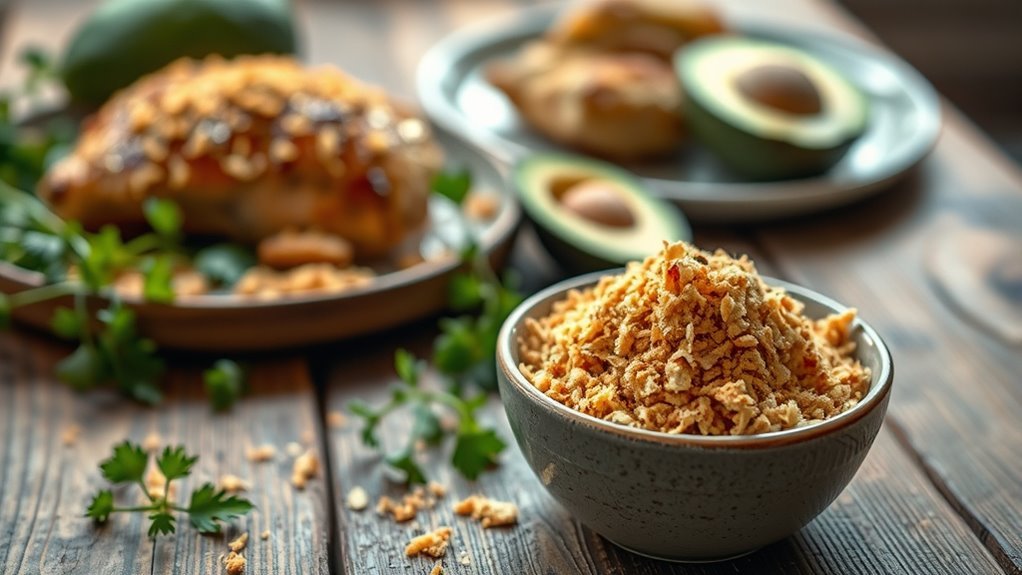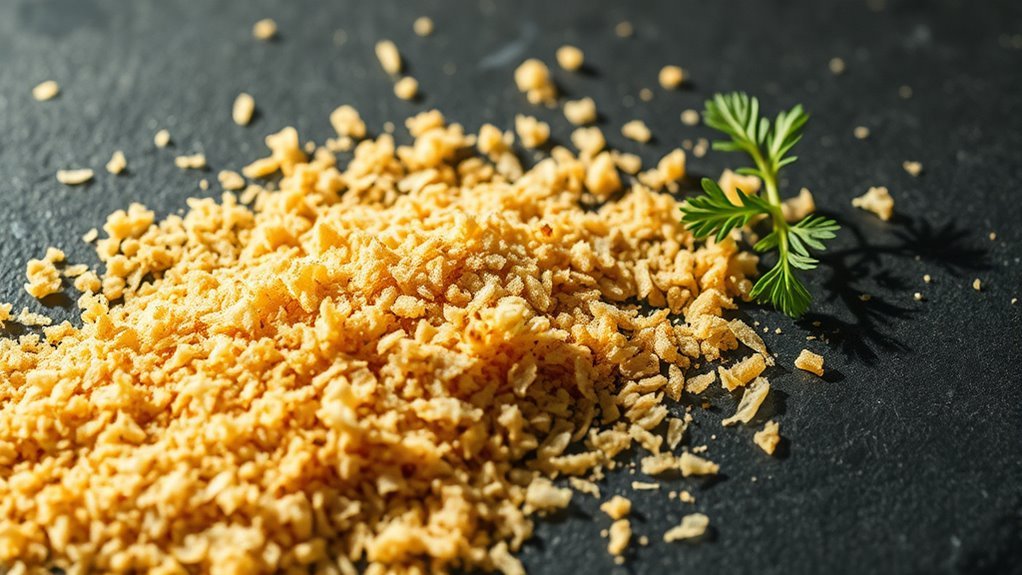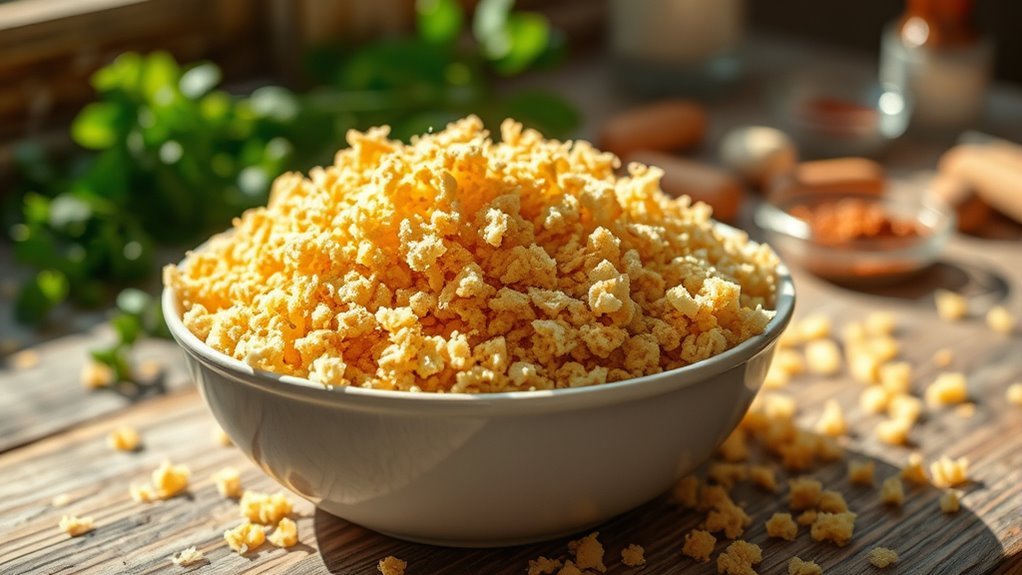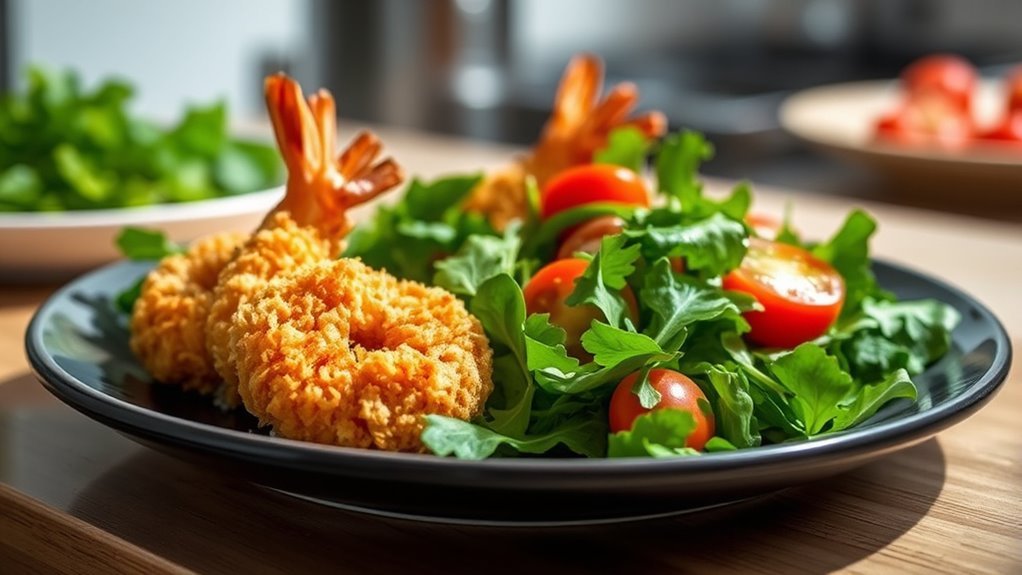Panko isn’t keto-friendly due to its high carbohydrate content. A typical serving contains around 30 grams of carbs, which can disrupt your low-carb goals. Compared to traditional breadcrumbs, panko is flakier, but that texture comes with extra carbs you likely want to avoid. Thankfully, there are alternatives like almond flour and crushed pork rinds that can help you achieve similar results without the carbs. You’ll discover more about these options and their benefits ahead.
Understanding Panko and Its Ingredients

Panko, a type of Japanese breadcrumb, is known for its light and airy texture, which makes it a popular choice for adding crunch to various dishes. Its origins trace back to Japan, where it was developed in the late 19th century, inspired by Western bread-making techniques. Unlike traditional breadcrumbs, panko is made from bread without crusts, resulting in larger, flakier crumbs. You’ll find various panko varieties, including regular and gluten-free options, catering to diverse dietary needs. This versatility allows you to use panko in everything from fried foods to baked dishes, enhancing texture and flavor. By understanding panko’s origins and varieties, you can appreciate its unique qualities and explore creative culinary uses.
Nutritional Profile of Panko

When considering panko, it’s essential to look at its carbohydrate content, as this can considerably impact a keto diet. Compared to traditional breadcrumbs, panko typically has a higher carbohydrate count, which may not align with your low-carb goals. Understanding these differences helps you make informed choices about incorporating panko into your meals.
Carbohydrate Content Analysis
Bread crumbs, particularly panko, contain a notable amount of carbohydrates, which can be a concern for those following a ketogenic diet. If you’re looking for low carb options, understanding panko’s carbohydrate content is essential. Here’s a breakdown of its nutritional profile:
| Serving Size (1/4 cup) | Total Carbohydrates (g) | Net Carbs (g) |
|---|---|---|
| Panko | 24 | 24 |
| Almond Flour | 6 | 2 |
| Coconut Flour | 12 | 8 |
As you can see, panko is a significant carbohydrate source compared to other alternatives. If you’re committed to a keto lifestyle, consider substituting panko with lower carb options to maintain your dietary goals.
Comparison to Traditional Breadcrumbs
Although many people enjoy the crunchy texture of panko, it’s important to compare its nutritional profile to that of traditional breadcrumbs. Panko typically contains fewer calories and carbs, making it an appealing option for those watching their intake. While traditional breadcrumbs might pack more fiber from whole grains, panko benefits from being lighter and crispier, leading to a satisfying crunch without the extra calories. When considering breadcrumb variations, remember that panko often comes from white bread, which may not align with all dietary goals. If you’re looking for a lower-carb alternative, panko could be a better choice, but be mindful of your overall nutrition and ingredient sources. Ultimately, select what aligns best with your dietary freedom and preferences.
The Carb Count in Panko

When considering the carb count in panko, it’s essential to note that a typical serving contains around 30 grams of carbohydrates. This level is often too high for a ketogenic diet, which usually restricts carb intake to about 20-50 grams per day. Fortunately, there are keto-friendly alternatives, such as almond flour or crushed pork rinds, that can help you achieve a similar crunchy texture without the extra carbs.
Carb Content Overview
If you’re considering incorporating panko into your meals while following a keto diet, it’s vital to understand its carbohydrate content. Panko, made from white bread, typically contains about 23 grams of carbs per 100 grams. This means it’s not a suitable option for those strictly adhering to a low-carb lifestyle, as it can quickly exceed your daily carb limit. While panko offers a lighter, crispier texture for dishes, it’s essential to explore alternative carb sources that align better with your keto goals. Instead of panko, consider low carb options like crushed pork rinds or almond flour for breading. These substitutes can help you maintain your keto diet while satisfying your craving for crunch without compromising your carb count.
Keto Alternatives Available
Finding suitable alternatives to panko that fit within a keto diet can be challenging, but there are several options to contemplate. Many keto-friendly flours and low carb coatings can serve as effective substitutes. Here’s a quick comparison of some popular choices:
| Alternative | Carb Count (per 1/4 cup) |
|---|---|
| Almond Flour | 6g |
| Coconut Flour | 12g |
| Pork Rinds | 0g |
| Ground Flaxseed | 0g |
| Parmesan Cheese | 1g |
These alternatives not only keep your carb intake low but also provide texture and flavor. Experimenting with these options can help you maintain a satisfying, keto-friendly diet without the need for traditional panko.
Comparing Panko to Traditional Breadcrumbs
While both panko and traditional breadcrumbs serve as popular coatings in various dishes, they differ markedly in texture and nutritional content. Panko, made from crustless bread, offers a lighter, airier texture that crisps up beautifully when cooked. This can enhance the overall experience of your meals. In contrast, traditional breadcrumbs tend to be denser and can absorb more moisture, which may lead to a soggier result. If you’re looking for panko benefits, you’ll find it often has fewer calories and carbs compared to its traditional counterpart, making it an appealing option for those seeking healthier breadcrumb substitutes. By understanding these differences, you can make informed choices about which type of breadcrumb suits your cooking needs best.
Keto-Friendly Alternatives to Panko
Since you’re following a keto diet, you might be on the lookout for alternatives to panko that align with your low-carb lifestyle. Almond flour is a popular choice, providing a nutty flavor and fine texture. Coconut flakes add a sweet twist, while crushed pork rinds offer a crunchy, savory option. For added fiber, consider chia seeds or flaxseed meal, both of which can enhance texture. Nutritional yeast not only adds a cheesy flavor but also boosts nutrients. Shredded cheese can create a crispy coating when baked, and psyllium husk can help bind ingredients together. These alternatives will keep your meals satisfying without compromising your ketogenic goals. Embrace these options to maintain variety in your diet!
Recipes to Try With Keto-Friendly Substitutes
Using keto-friendly substitutes can open up a world of delicious recipes that fit perfectly within your low-carb lifestyle. For instance, try using crushed pork rinds or almond flour as keto alternatives for traditional breadcrumbs in meatballs or baked chicken. You can also create a crispy topping for casseroles by mixing shredded cheese and crushed nuts. For a low-carb pizza crust, consider using cauliflower or zucchini blended with cheese. Additionally, make your own keto-friendly breading by combining ground flaxseed and parmesan cheese for a crunchy finish on fish or veggies. These low carb recipes not only satisfy your cravings but also allow you to enjoy comfort foods guilt-free while sticking to your keto goals.
Tips for Cooking Without Panko
If you’re looking to cook without panko, there are several effective strategies that can help you achieve that desired crunch and texture. By exploring alternative cooking techniques and ingredient substitutions, you can create satisfying dishes without sacrificing flavor.
- Crushed pork rinds for a savory crunch
- Ground nuts like almonds or pecans for a rich, nutty flavor
- Grated Parmesan cheese for a cheesy, crispy finish
- Coconut flakes for a hint of sweetness and crunch
- Gluten-free breadcrumbs for a similar texture without gluten
These methods not only enhance your meals but also allow you to embrace a keto lifestyle more freely. So, don’t hesitate to experiment and discover the perfect alternative that excites your taste buds while keeping your cooking aligned with your dietary choices.
The Role of Texture in Keto Cooking
Texture plays a significant role in keto cooking, influencing not just the enjoyment of a meal but also the overall satisfaction derived from it. By employing various texture techniques, you can create crunchy contrasts that enhance each dish. Mixing creamy elements with crunchy toppings not only elevates flavor enhancement but also promotes sensory satisfaction. Embracing cooking creativity allows for texture balance, ensuring your meals remain exciting and diverse. Think about plating presentation; a visually appealing dish often teases the palate even before the first bite. By focusing on dish diversity, you can explore different textures, from tender to crispy, making your keto journey more enjoyable. Ultimately, mastering texture is key to a fulfilling and flavorful keto experience.
Final Thoughts on Using Panko on a Keto Diet
While many people on a keto diet seek to minimize carbohydrate intake, it’s important to contemplate the impact of alternatives like panko breadcrumbs. If you’re considering panko usage in your keto meal prep, weigh the pros and cons carefully. Here’s what you should think about:
- Traditional panko is high in carbs, which can derail your keto goals.
- Alternatives like crushed pork rinds offer a crunchy texture with fewer carbs.
- Experimenting with keto-friendly substitutes can keep your meals exciting.
- The right choice can help you feel satisfied without compromising your diet.
- Ultimately, the goal is to maintain freedom in your eating habits while staying within your nutritional framework.
Choose wisely to make the most of your keto journey!
Frequently Asked Questions
Can I Find Gluten-Free Panko Options?
Yes, you can find gluten-free panko options! Several brands offer gluten-free alternatives that still provide that crispy texture you’re looking for. Brands like Kikkoman and Ian’s offer gluten-free panko, made from rice or other gluten-free grains. When shopping, read the labels carefully to guarantee they meet your dietary needs. This way, you can enjoy your favorite dishes without compromising on taste or texture. Enjoy exploring these delicious options!
How Does Panko Affect the Texture of Keto Dishes?
Panko’s like a magician’s wand, transforming your keto dishes with delightful texture enhancement. Its airy, crispy flakes create a light crunch that elevates presentation, making your meals visually stunning and appetizing. With each bite, you’ll experience a satisfying contrast against softer ingredients, bringing your culinary creations to life. Just remember, while panko adds flair, sticking to keto-friendly alternatives is key to maintaining your dietary goals without sacrificing that irresistible crunch.
Is Panko Suitable for a Low-Carb Diet?
Panko isn’t suitable for a low-carb diet, as it’s primarily made from white bread, which is high in carbohydrates. If you’re looking for low carb alternatives, consider using crushed pork rinds, almond flour, or coconut flour as keto-friendly substitutes. These options can provide similar texture without the carbs, allowing you to enjoy your dishes while staying true to your low-carb lifestyle. Always check labels to guarantee you’re making the best choices for your diet.
What Are the Origins of Panko Breadcrumbs?
Panko breadcrumbs originated in Japan, designed to enhance the texture of dishes in Japanese cuisine. Unlike traditional breadcrumbs, panko’s unique flaky texture results from a specific baking process using electric currents. This method produces larger, airier crumbs that crisp up beautifully when fried. You’ll find panko elevating everything from tempura to katsu, showcasing its versatility among breadcrumb types. It’s a demonstration of how culinary innovations can transform familiar ingredients into something extraordinary.
Can I Use Panko in Frying Recipes?
Yes, you can use panko in frying recipes, as it’s excellent for creating a crispy texture. If you’re looking for panko alternatives, consider crushed nuts or pork rinds for a low-carb option. When using panko, make certain your frying techniques include preheating the oil properly and not overcrowding the pan, which can lead to sogginess. Both methods can elevate your dishes, giving you that delightful crunch you crave while frying.


